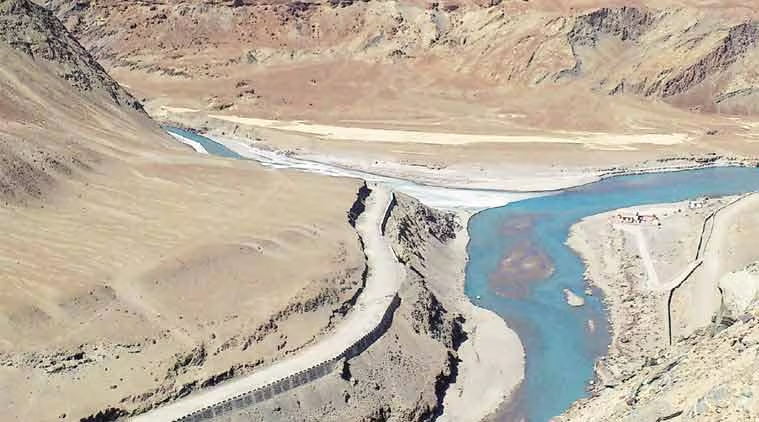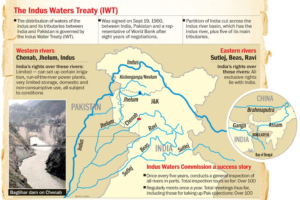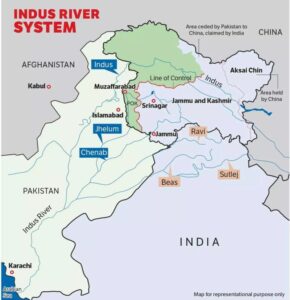
The Indus Waters Treaty and Its Function in Maintaining Indo-Pak Relations: The Lifeline Agreement
Throughout human history water has been a source of both conflict and sustenance. Millions of people’s lives have been impacted by the balance between collaboration and conflict in the Indus River Basin which is shared by India and Pakistan. One of the most notable instances of a successful water-sharing agreement between two countries that are frequently involved in political disputes is the Indus Waters Treaty (IWT) which was signed in 1960.
An Overview of the Indus River Basin’s History

One of the world’s longest rivers the Indus empties into the Arabian Sea after passing through China India and Pakistan. For millions of people the river and its tributaries—the Chenab Jhelum Ravi Beas and Sutlej—support daily life industry and agriculture. Conflicts over the use and management of these vital water resources emerged after British India was divided in 1947.
Pakistan became downstream and dependent on water from India as a result of the political division brought about by partition. This reliance increased Pakistan’s concerns that India might restrict water flow by using its upstream location endangering the country’s agricultural and economic stability. As tensions increased the World Bank mediated negotiations.
The Treaty’s Formation and Structure
The World Bank acted as a third-party mediator and guarantor when Indian Prime Minister Jawaharlal Nehru and Pakistani President Ayub Khan signed the Indus Waters Treaty on September 19 1960. The Indus Basin’s rivers were split into two groups by the treaty:
- The Indus Jhelum and Chenab rivers in the west are allotted to Pakistan.
- India is the owner of the eastern rivers the Ravi Beas and Sutlej.
The treaty gives India permission to use the Western Rivers’ waters for non-consumptive uses like producing hydropower, but it gives Pakistan the sole right to use them for agriculture and irrigation. A framework for collaboration was also established by the agreement, which included procedures for information sharing, inspections, and dispute resolution.
Supreme Court Judges
Importance and Heritage

Many people consider the Indus Waters Treaty to be one of the world’s most enduring water-sharing accords. Both parties have mostly complied with the treaty in spite of conflicts political upheavals and tense relations between India and Pakistan. Its resilience is due to a number of important factors:
- Clarity: Each party’s rights and obligations are spelled out in detail in the treaty.
- Institutional Mechanisms: A forum for discussion and conflict resolution is offered by the Permanent Indus Commission which was created by the treaty.
- Third-Party Mediation: The participation of the World Bank offers an additional degree of impartiality and accountability.
Due to the treaty’s equitable distribution of water resources millions of people in both countries are now able to prosper economically and agriculturally. Additionally it has established a standard for global collaboration in the management of transboundary water resources.
Obstacles and Remarks

Despite its success the treaty has encountered difficulties. The treaty according to critics falls short in addressing new problems like population growth climate change and rising water demand. Concerns have also been raised by some Indians that the country’s capacity to develop its water resources is constrained by the prohibitions on the use of Western Rivers.
The treaty is under additional strain as a result of recent political developments. The treaty’s provisions have been put to the test and raised concerns in Pakistan due to recurring disputes over projects like India’s Kishanganga and Ratle hydroelectric dams. However, up until now, the dispute resolution procedures have kept these tensions from turning into significant wars.
Gazing Ahead
Even in the most difficult geopolitical situations collaboration is achievable as the Indus Waters Treaty reminds us. The flexibility and adaptability of the treaty will be tested as climate change threatens to change water availability and patterns. The treaty’s ongoing success will depend on bolstering cooperation, making investments in sustainable water management, and tackling common issues.
The Indus Waters Treaty provides important lessons in diplomacy, trust-building, and the value of compromise in a world where water scarcity is becoming a global crisis. It continues to be vital to India and Pakistan, not only for their rivers but also for the region’s hopes of peace and collaboration.
DPVNATION





